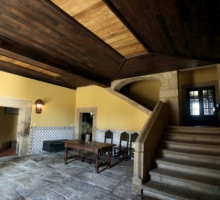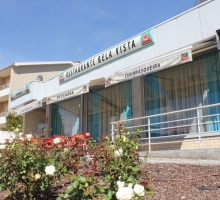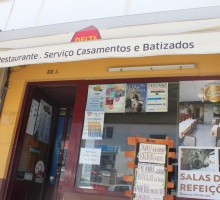The implementation of Pedestrian Routes Network of Moimenta da Beira, follows as a result of an integrated plan, which was born on the one hand as an adjusted action in the project "The Paiva more alive" under the Operational Programme - AGRIS, whose objective was based on the valuation of the environment and rural heritage of the Paiva River area and its nearest surroundings, and on the other, as a contribution to the enrichment of Study Design, Promotion and Dissemination of Moimenta da Beira Cultural Routes - Pedestrian Routes Network candidate to Leader + Program, having as postulate to create a complementary offer that benefits the attractiveness of tourist composite - Nature Tourism, indicated in the National Strategic Plan for Tourism (PENT) as a tourism product to be developed in NUT II North Region that brings together the Tourist pole Douro, where Moimenta da Beira is inserted.
It is in this context that have arisen in Moimenta da Beira municipality three small routes that reflect the cultural and natural diversity of this territory:
Route Paiva -PR1
The Paiva follows through the landscape relief becoming a beautiful nature reserve and of those who have chosen this route to enjoy breathtaking scenery.
The secret of these people is assumed in its traditions, in the field cultivation, in living the life cycles and their hues colorings. To enjoy these lands it is necessary to walk, going on foot and stepping hard on tracks and paths that carry with them a wonderful world where rural life still earns genuineness contours.
In Segões starts the footpath called "Paiva Route", which with its 21km is inserted in the Pedestrian Routes network Moimenta da Beira.
Its central space is the basin of the river Paiva, one of the least polluted rivers in Europe, allowing the visitor contact with an extraordinary biodiversity (aquatic and terrestrial), and having access to the set of small humanized landscape points, materialized in cultivated fields, in buildings of past times, in the strength of its people.
Rota da Serra - PR2
Its central theme concerns the mountains (Serra de Leomil and Planalto da Nave);
It is in Pera Velha where begins the "Rota da Serra", a pedestrian route of 26.5 kilometers away that deserves to be traveled by the diversity of environments that transmits. It is inserted in Pedestrian Routes Network of Moimenta da Beira containing the "Paiva Route that runs along the Paiva river basin and Távora Route" that accompanies the basin of the Vilar Dam.
You must visit the recently restored community oven and the mother church of the eighteenth century. The route then goes north into the Serra de Leomil. Immediately after the perimeter of the village the visitor can see the rock formations of granite, many of which are associated with the imagination and popular tradition of the local people.
The route passes near the village of Carapito and continues to Leomil through dense pine forests and the magnificent plateau which overlooks Moimenta Távora river basin.
The passage through Leomil village allows the experience of a village full of history and monuments. From here the route climbs to the highest point at the top of Leomil saw, where the scenery is fabulous. Its foundation refers to nationality with Couto de Leomil institution, one of the most famous and extensive from the medieval period according to medieval documents that make reference to this land and its people. By the parish memories of 1758, we can see that the parish has three full locations: Paraduça, Sarzedo and Semitela and half of Beira Valente, as the other belonged to the Castle. Set "(...) in a valley in the Serra diapers (...)", it had 584 people distributed among various villages.
Traces of these times are some noble architecture copies that still persistst in the urban core of Leomil which sets out the houses of Visconde de Balsemão , of Coutinho and Sarmento, beyond the Pelourinho de Gaiola and the old building of the Town Hall, extinct during the liberal territorial reorganization. These elements of civil architecture are the perfect composite for hikers to know and imagine episodes of the historicity of this village.
Alvite is another land crossed by this route. Belonging for centuries to the Monastery of São João Baptista de Tarouca, Cistercian Order. D. Afonso Henriques in 1160 gave the people of Alvite to Tarouca Monastery, being the possession confirmed in 1163 by Pope Alexander III, appearing documented the “ Granja de Alvite”. Reportedly, the monks were the major drivers of agricultural development in this location. To prove this fact, appear in the terms as granary and barn. This reckless and persevering people braved the mountains and turned it into agricultural land, maintaining the authenticity of the uses and customs that is at its greatest legacy as evidenced by the House Museum or the many properties of rural architecture dotting the interior of Alvite.
The route goes by the plateau of Nave where is one of the most important prehistoric necropolis in the country with dozens of tomb monuments of the Neolithic and Bronze Age.
The path ends in Pêra Velha, crossing the territory of geological environment, in which it have started.
Route Távora PR3
The central theme is the dam (river Távora)
This route starts in the Camping of Vilar Dam. The central theme is the reservoir of the Vilar dam. Indeed, this water table created by the dam allows the observation of a wide range of fauna and flora. The scenery is stunning and there are still along the dam several points of leisure that can support the visitor.
About half of this route, the west half, crosses pine forest environments and humanized environments where the hikers can have a very close contact with the rural world and the main agricultural productions of the county. Here there are extensive apple orchards and vineyards, olive groves and hazelnut orchards. Still in this area the route passes through the towns of Vilar, Vide and Rua. They are villages full of history and soul. With a more urban aspect than the villages of Serra, still maintains therefore a rurality that characterizes them. In terms of heritage, and compared to the story told by Rota da Serra, this route shows the remains of the Roman occupation perpetrated in the various tomb monuments and votive gravestones which are reused in more recent buildings.
You can also consult the blog: http://turirotas.blogspot.pt/
Location: Moimenta da Beira
It is in this context that have arisen in Moimenta da Beira municipality three small routes that reflect the cultural and natural diversity of this territory:
Route Paiva -PR1
The Paiva follows through the landscape relief becoming a beautiful nature reserve and of those who have chosen this route to enjoy breathtaking scenery.
The secret of these people is assumed in its traditions, in the field cultivation, in living the life cycles and their hues colorings. To enjoy these lands it is necessary to walk, going on foot and stepping hard on tracks and paths that carry with them a wonderful world where rural life still earns genuineness contours.
In Segões starts the footpath called "Paiva Route", which with its 21km is inserted in the Pedestrian Routes network Moimenta da Beira.
Its central space is the basin of the river Paiva, one of the least polluted rivers in Europe, allowing the visitor contact with an extraordinary biodiversity (aquatic and terrestrial), and having access to the set of small humanized landscape points, materialized in cultivated fields, in buildings of past times, in the strength of its people.
Rota da Serra - PR2
Its central theme concerns the mountains (Serra de Leomil and Planalto da Nave);
It is in Pera Velha where begins the "Rota da Serra", a pedestrian route of 26.5 kilometers away that deserves to be traveled by the diversity of environments that transmits. It is inserted in Pedestrian Routes Network of Moimenta da Beira containing the "Paiva Route that runs along the Paiva river basin and Távora Route" that accompanies the basin of the Vilar Dam.
You must visit the recently restored community oven and the mother church of the eighteenth century. The route then goes north into the Serra de Leomil. Immediately after the perimeter of the village the visitor can see the rock formations of granite, many of which are associated with the imagination and popular tradition of the local people.
The route passes near the village of Carapito and continues to Leomil through dense pine forests and the magnificent plateau which overlooks Moimenta Távora river basin.
The passage through Leomil village allows the experience of a village full of history and monuments. From here the route climbs to the highest point at the top of Leomil saw, where the scenery is fabulous. Its foundation refers to nationality with Couto de Leomil institution, one of the most famous and extensive from the medieval period according to medieval documents that make reference to this land and its people. By the parish memories of 1758, we can see that the parish has three full locations: Paraduça, Sarzedo and Semitela and half of Beira Valente, as the other belonged to the Castle. Set "(...) in a valley in the Serra diapers (...)", it had 584 people distributed among various villages.
Traces of these times are some noble architecture copies that still persistst in the urban core of Leomil which sets out the houses of Visconde de Balsemão , of Coutinho and Sarmento, beyond the Pelourinho de Gaiola and the old building of the Town Hall, extinct during the liberal territorial reorganization. These elements of civil architecture are the perfect composite for hikers to know and imagine episodes of the historicity of this village.
Alvite is another land crossed by this route. Belonging for centuries to the Monastery of São João Baptista de Tarouca, Cistercian Order. D. Afonso Henriques in 1160 gave the people of Alvite to Tarouca Monastery, being the possession confirmed in 1163 by Pope Alexander III, appearing documented the “ Granja de Alvite”. Reportedly, the monks were the major drivers of agricultural development in this location. To prove this fact, appear in the terms as granary and barn. This reckless and persevering people braved the mountains and turned it into agricultural land, maintaining the authenticity of the uses and customs that is at its greatest legacy as evidenced by the House Museum or the many properties of rural architecture dotting the interior of Alvite.
The route goes by the plateau of Nave where is one of the most important prehistoric necropolis in the country with dozens of tomb monuments of the Neolithic and Bronze Age.
The path ends in Pêra Velha, crossing the territory of geological environment, in which it have started.
Route Távora PR3
The central theme is the dam (river Távora)
This route starts in the Camping of Vilar Dam. The central theme is the reservoir of the Vilar dam. Indeed, this water table created by the dam allows the observation of a wide range of fauna and flora. The scenery is stunning and there are still along the dam several points of leisure that can support the visitor.
About half of this route, the west half, crosses pine forest environments and humanized environments where the hikers can have a very close contact with the rural world and the main agricultural productions of the county. Here there are extensive apple orchards and vineyards, olive groves and hazelnut orchards. Still in this area the route passes through the towns of Vilar, Vide and Rua. They are villages full of history and soul. With a more urban aspect than the villages of Serra, still maintains therefore a rurality that characterizes them. In terms of heritage, and compared to the story told by Rota da Serra, this route shows the remains of the Roman occupation perpetrated in the various tomb monuments and votive gravestones which are reused in more recent buildings.
You can also consult the blog: http://turirotas.blogspot.pt/
Location: Moimenta da Beira








